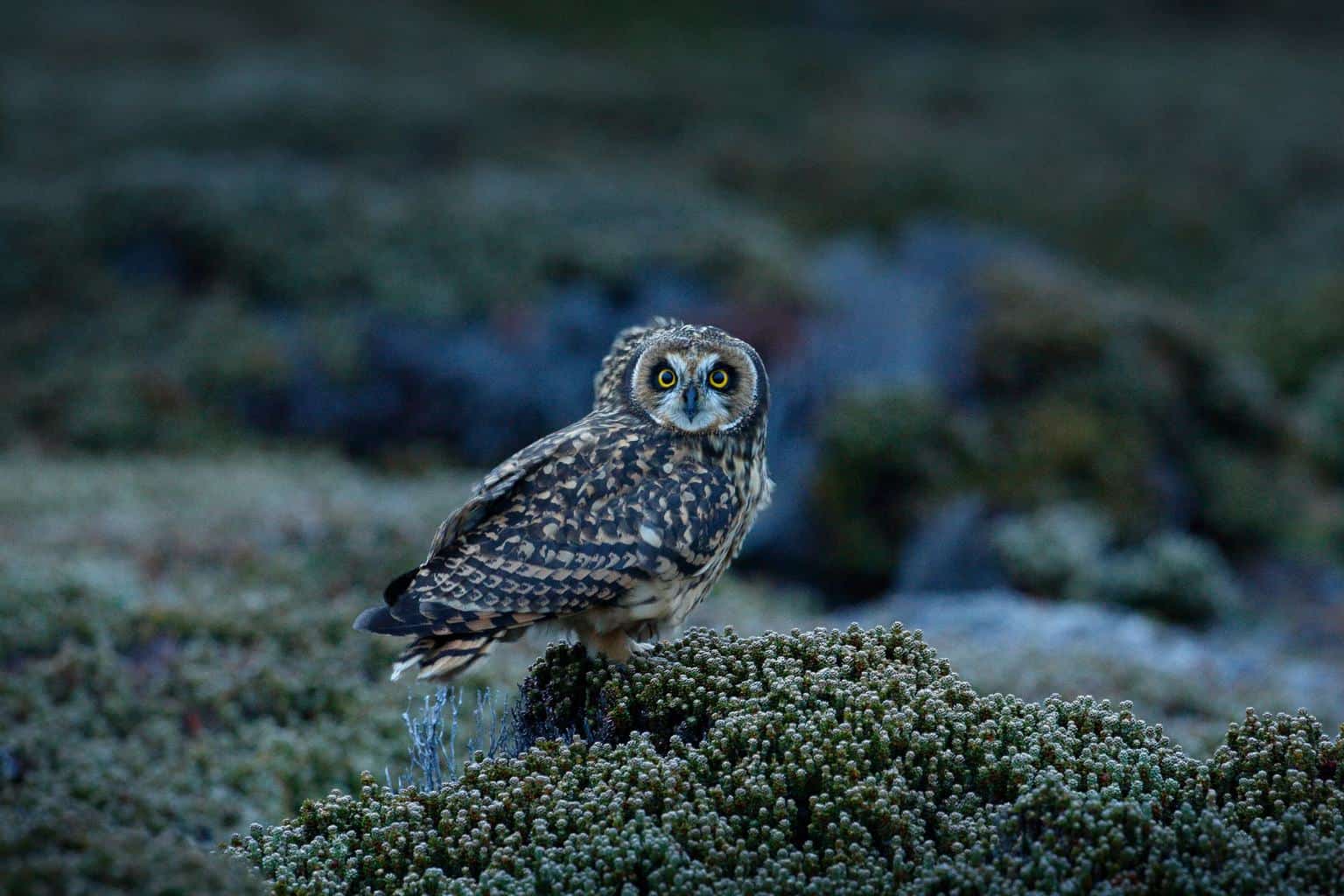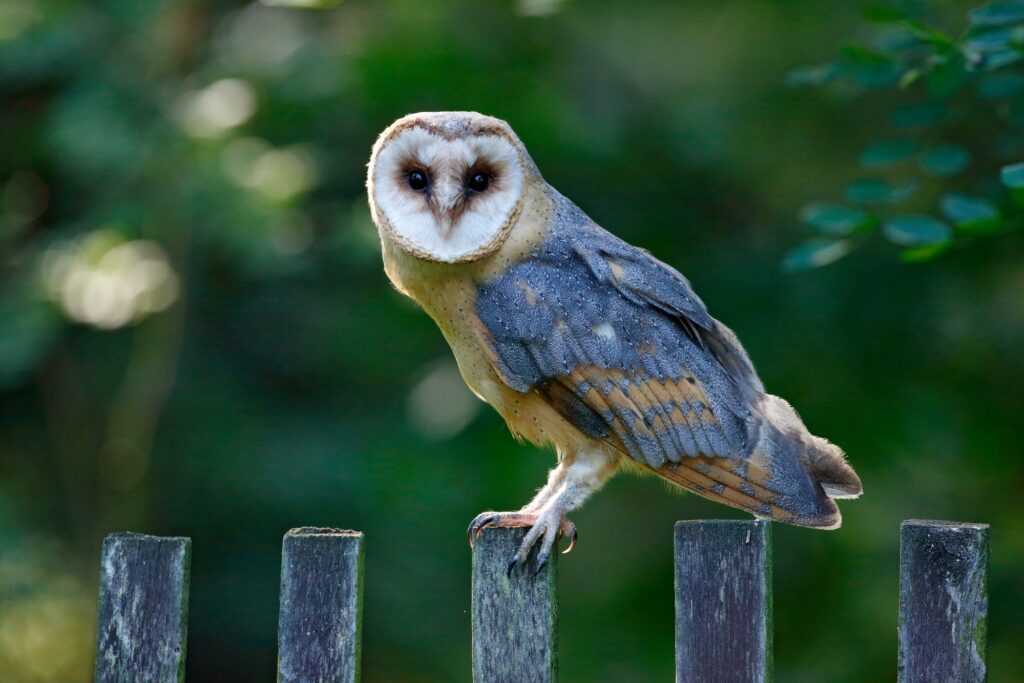People love to visit Indiana because of its diversity of attractions. You can visit historical landmarks, museums, state parks, and national parks!
And when it comes to birdwatching (which we’re assuming you’re interested in because you’re on this website), heading out to the woodland at dusk or dawn will almost certainly guarantee you see one of the eight owls that reside in Indiana.
Some of these birds of prey are permanent residents of the state and stay there year-round, while others are found only during the winter months. But today, we’re getting to know all of the owls you’ll find in Indiana and how to spot them. This way, you’ll have good luck on your birdwatching endeavors no matter what time you find yourself in the state!
Barred Owl

- Scientific Name: Strix varia
- Length: 17-19.7 inches
- Weight: 16.6-37 ounces
- Wingspan: 39-43.3 inches
Barred owls prefer to stay deep within Indiana’s deep forests, steering away from the outer woodland parts where great horned owls reside because the two are enemies — the great horned bird may also try to eat our barred friend!
These owls love to nest in tree cavities, which is why they can stay in a tree on a building property if the tree has a cavity that could accommodate a nest.
Barred owls are fairly large. They sport mottled brown and white plumage that blends well with their surroundings, but even if you don’t see them, you might hear their hoots during the day or night. They sound like they’re asking, “Who cooks for you?”
Unlike most species of owls, barred owls prefer fish and crayfish to mammals. If they could, they’d boast of their hunting skills; sometimes they even wade in the water until they catch a fish! But, this doesn’t mean these birds won’t feed on small mammals and rodents when they’re available, though…they will!
Great Horned Owl

- Scientific Name: Strix varia
- Length: 18-24.8 inches
- Weight: 32-88.2 ounces
- Wingspan: 39.8-57 inches
Great horned owls love to dwell among the trees and woodlands. You can find this year-round resident of Indiana in a wide range of habitats, including swamps, open fields, deserts, or urban areas.
These birds are hefty and have long ear tufts and large rounded wings that are silent as they flap so as not to catch the attention of the prey item they’ve set their sights on. And speaking of wings, the great horned owl has external mottled grey-brown feathers that are slightly paler around its underparts. Its face is somewhat orangey, and it has distinctive yellow eyes.
The great horned owl is strictly nocturnal, so it only hunts at night. So naturally, it has outstanding night vision and exceptional hearing skills that help it find its favorite foods in the darkness. Its heart-shaped face also helps direct sounds to its ears.
One of the great horned owl’s nicknames is the tiger owl. This is fitting because it ruthlessly attacks anything — rats, scorpions, skunks, geese, hawks, and even humans!
Eastern Screech-Owl

- Scientific Name: Megascops asio
- Length: 6.4-9.8 inches
- Weight: 4.3-8.5 ounces
- Wingspan: 19-24 inches
The eastern screech-owl is Indiana’s smallest-sized owl citizen. They’re petite and robin-sized while stocky, boasting rounded wings and square-shaped tails. They occur in grey and red color morphs, each with dark vertical streaks and lighter underparts.
These birds love a neat nest and can make a home in small tree cavities. They’ve also been known to take over previously made nests, which is why you can find them in your backyard or urban areas in general.
Screech-owls have a varied diet that includes small birds, mammals, worms, rabbits, moles, and mice. Sometimes, they’ll store their food in tree cavities so they can eat it later.
While you won’t necessarily spot an eastern screech-owl because it’s strictly nocturnal, you’re sure to hear one. These birds of prey have one of the widest vocal ranges among all owls, and if you’re lucky, you’ll hear its whinnying song.
Barn Owl

- Scientific Name: Tyto furcata
- Length: 12.6-15.8 inches
- Weight: 14-24.7 ounces
- Wingspan: 39.4-49.2 inches
Though barn owls are found in abundance across the globe, they’re a rare occurrence in Indiana and the midwest region of the United States in general.
Barn owls are known for their heart-shaped faces and small, dark eyes. The medium-sized birds have pale grey faces and underparts and cinnamon-colored plumage on their backs. There’s some subtle spotting on the underparts, too.
As the species’ name suggests, barn owls love nesting in barns. They used to prefer tree cavities but the birds have since adapted to barns and other manmade structures.
Unfortunately, the number of barn owls in Indiana is declining. This is largely because of farmers changing open pastures — the land where barn owls used to hunt — to rows of crops.
You’ll easily identify the species’ sound, as it’s high-pitched and sounds like a scream. If you hear this sound, it means there’s a barn owl nearby trying to attract a mate or in distress.
Snowy Owl

- Scientific Name: Bubo scandiacus
- Length: 20.5-28 inches
- Weight: 56.4-104 ounces
- Wingspan: 49.6-57 inches
Snowy owls are slightly larger than the great horned species and are the largest and heaviest in Indiana. They have stocky bodies with wide, dense plumage to protect them from the freezing tundra temperatures they live in.
Males are mostly all-white, while females are slightly darker and have some grey spots. A male snowy owl will usually try a V-shaped dive as he flies through the air in hopes of impressing a female, and he might also use a loud “hoo, hoo” call to search for a mate or signal danger.
Another remarkable feature of the snowy owl species is the bird’s yellow eyes and the feathers that surround them. These feathers help direct sound toward their ears, which are located right behind their eyes and make them more efficient hunters.
Unlike most owls, snowy owls aren’t strictly nocturnal. They’ll go out during the day for hunting where, on average, a snowy owl needs to catch seven to 12 mice to meet its daily requirement for food.
Snowy owls are so aggressive that there have been some records of them trying to attack wolves — the audacity!
Short-Eared Owl

- Scientific Name: Bubo scandiacus
- Length: 13.4-17 inches
- Weight: 7.3-16.8 ounces
- Wingspan: 33.5-40.5
Short-eared owls are medium-sized birds with brown plumage and tiny ear-like tufts of feathers, and good news, birdwatcher: they’re a common occurrence in northern Indiana year-round!
The short-eared owl loves open areas and grasslands, where it likes to perch on low trees and vegetation near the ground.
A native of Hawaii, the short-eared owl can travel over long distances over oceans to breed. During their breeding season, these birds tend to be overly active both day and night. The female will nest to incubate the eggs, while the male will take on the duty of distraction to protect his spouse and offspring from intruders.
Long-Eared Owl

- Scientific Name: Asio otus
- Length: 13.8-15.8 inches
- Weight: 7.8-15.3 ounces
- Wingspan: 35.4-39.4 inches
As the birds’ name suggests, long-eared owls have one of the longest ear-like tufts of feathers among owl species. Their long, slender ears, coupled with yellow eyes and orange faces, give them an expression of constant surprise.
Long-eared owls are medium size, but they’re remarkably slimmer than other species. Their plumage is dark brown with light bars that help them camouflage. Because they prefer to hide out in dense foliage, you won’t easily spot a long-eared owl in its natural habitat.
While they’re widely spread across the United States, you can only find long-eared owls in Indiana outside of their breeding season. And speaking of breeding…interestingly enough, these birds are monogamous. Males court females during their breeding season, and they form colonies in which they breed. There’s no information about whether or not the pair stays together in the long term, though.
Northern Saw-Whet Owl

- Scientific Name: Aegolius acadicus
- Length: 7-8.3 inches
- Weight: 2.3-5.3 ounces
- Wingspan: 16.5-29 inches
There’s a theory that the northern saw-whet owl got its name from the sound it makes, which is something that resembles a saw being sharpened against a whetting stone.
This species has chocolate brown feathers on its back and lighter underparts. They’re also known for the V-shape between their two yellow eyes that distinguish them from other species.
Northern saw-whet owls are petite with compact bodies and small heads, and they’re one of the smallest bird species in Indiana and arguably across the whole country.
You can find northern saw-whet owls in the northern regions of Indiana year-round, and they love dense forests that are close to water surfaces. They’re nocturnal, and their brown plumage makes them hard to spot, but you can follow their distinctive shrill to know where they reside.
In Conclusion
Indiana is one of the United States’ richest territories as far as wildlife is concerned. Not only are there beautiful owls, but there are also several species of woodpeckers and hawks that make their home in the state — it’s a goldmine for you birding enthusiasts!

